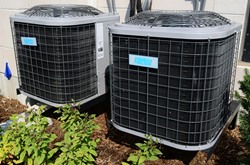How to Select the Right HVAC Program near Ashland Montana
 Once you have decided on a career as a heating and air conditioning specialist, the next action is to choose an HVAC technical school near Ashland MT. But with so many to choose from, how do you choose the right one to obtain the training that you require? Some prospective students will make their decision based solely on the price of tuition or how close the school is to their home. While these are important considerations, they are not the only ones to evaluate. Just some of the other things that you need to investigate are the graduation completion rates of the HVAC schools, their reputations, and if they are accredited by professional trade organizations. Those and other criteria will be discussed in more detail later in this article. But before we discuss how to choose an HVAC vocational school, let’s take a look at what a heating and cooling technician does to become a licensed skilled tradesman.
Once you have decided on a career as a heating and air conditioning specialist, the next action is to choose an HVAC technical school near Ashland MT. But with so many to choose from, how do you choose the right one to obtain the training that you require? Some prospective students will make their decision based solely on the price of tuition or how close the school is to their home. While these are important considerations, they are not the only ones to evaluate. Just some of the other things that you need to investigate are the graduation completion rates of the HVAC schools, their reputations, and if they are accredited by professional trade organizations. Those and other criteria will be discussed in more detail later in this article. But before we discuss how to choose an HVAC vocational school, let’s take a look at what a heating and cooling technician does to become a licensed skilled tradesman.
How to Become an HVAC Technician
 HVAC is an acronym that is widely used in the trade that stands for “Heating, Ventilation and Air Conditioning”. HVAC techs provide services for the installation, maintenance and repair of central air conditioners, furnaces, boilers, hot water heaters and heating systems. As professional tradesmen, they are typically required to be licensed, though every state and local municipality has its own requirements. Attaining professional certification is not compulsory, but a voluntary means for Ashland MT HVAC technicians to prove that they are exceptionally proficient and knowledgeable in their area of expertise. There are several acknowledged certifications within the industry that are offered. Below are a few of the important ones.
HVAC is an acronym that is widely used in the trade that stands for “Heating, Ventilation and Air Conditioning”. HVAC techs provide services for the installation, maintenance and repair of central air conditioners, furnaces, boilers, hot water heaters and heating systems. As professional tradesmen, they are typically required to be licensed, though every state and local municipality has its own requirements. Attaining professional certification is not compulsory, but a voluntary means for Ashland MT HVAC technicians to prove that they are exceptionally proficient and knowledgeable in their area of expertise. There are several acknowledged certifications within the industry that are offered. Below are a few of the important ones.
- North American Technician Excellence (NATE). NATE is a nationally acknowledged certification for HVAC technicians. The certification is achieved by passing a proficiency exam and can be acquired in one or more specialties.
- HVAC Excellence. This certification offers both a professional and a master specialist credential. 2 years of professional experience together with passing a comprehensive exam are needed for the professional level certification. Master specialists need to have three years of experience as well as a passing result on the professional level exam. As with NATE, certifications are made available in multiple specialties.
- EPA Section 608. This certification is mandatory for specialists that work with refrigerants. There are 3 types of certification obtainable, one for small appliances, and the additional two for low and high pressure refrigerants.
Since licensing may be mandated in your location, and you may also intend to earn certification, it’s imperative that you enroll in an HVAC technical school that will train you for both. And since you will more than likely be handling refrigerants, make sure that the program you choose readies you for passing the EPA Section 608 examinations.
HVAC Certificate and Degree Training Programs
 There are a number of choices available for HVAC instruction in a technical or trade school. You can obtain a certificate, an Associate Degree, or a Bachelor’s Degree. Acquiring a certificate will take the minimum period of time, typically accomplished in as little as 6 months, however some programs are longer. A certificate will train you for most HVAC positions, especially if you are licensed and have certification relevant to the position. The degree programs may provide a competitive advantage in the job market and will deliver more comprehensive training than the certificate programs. Following is a brief summary of each credential offered near Ashland MT.
There are a number of choices available for HVAC instruction in a technical or trade school. You can obtain a certificate, an Associate Degree, or a Bachelor’s Degree. Acquiring a certificate will take the minimum period of time, typically accomplished in as little as 6 months, however some programs are longer. A certificate will train you for most HVAC positions, especially if you are licensed and have certification relevant to the position. The degree programs may provide a competitive advantage in the job market and will deliver more comprehensive training than the certificate programs. Following is a brief summary of each credential offered near Ashland MT.
- Certificate. Generally requiring a high school diploma, certificate programs are very popular among entry level commercial or residential HVAC technicians. They furnish a strong foundation of skills for employment within the trade.
- Associate Degree. The Associate Degree in HVAC program provides a more detailed understanding of heating & cooling systems than the certificate program. Generally requiring 2 years to finish, many degrees include an internship or work-study program.
- Bachelor’s Degree. The Bachelor’s Degree in HVAC is tailored more for a career in management as well as business ownership. Some programs call for an Associate Degree, while others are a standard 4 year program. In addition to mastering how to service and maintain heating and air conditioning systems, you will also study how to design them.
Selecting the ideal credential program will be based on what your future career goals are, together with the time and money that you have to commit. One possibility is to start with a certificate or perhaps an Associate Degree program, and after acquiring some experience in the trade in Ashland MT, eventually returning to acquire a Bachelor’s Degree. If this is your tactic, make certain to ask the HVAC technician school you are looking at about how their returning student program works.
HVAC Training Online
 Choosing an HVAC program online is one possibility to attaining your education and receiving a degree or certificate. Most schools will require some attendance on campus to participate in practical training. Some also offer internship or work-study programs in addition to or in place of practical lab work. But since the rest of the classes can be participated in on the web, this alternative may be a more practical solution for many Ashland MT students that are pressed for time. And a number of online degree programs are less costly than other on campus alternatives. Even commuting expenses from Ashland and study materials may be reduced, helping to make schooling more budget-friendly. And many online programs are fully accredited (more on this later). So if your work or family responsibilities have left you with minimal time to attend classes, perhaps an HVAC online training program will make it less complicated to accommodate school into your hectic lifestyle.
Choosing an HVAC program online is one possibility to attaining your education and receiving a degree or certificate. Most schools will require some attendance on campus to participate in practical training. Some also offer internship or work-study programs in addition to or in place of practical lab work. But since the rest of the classes can be participated in on the web, this alternative may be a more practical solution for many Ashland MT students that are pressed for time. And a number of online degree programs are less costly than other on campus alternatives. Even commuting expenses from Ashland and study materials may be reduced, helping to make schooling more budget-friendly. And many online programs are fully accredited (more on this later). So if your work or family responsibilities have left you with minimal time to attend classes, perhaps an HVAC online training program will make it less complicated to accommodate school into your hectic lifestyle.
What to Ask HVAC Trade Schools
 Once you have chosen the type of certificate or degree that you desire to acquire, either online or on campus, you can begin to limit your selection of schools. As you are no doubt aware, there are a large number of HVAC vocational schools in the Ashland MT area and all over the United States to pick from. That’s why it is extremely important to have a checklist of important qualifiers when making school comparisons. As earlier stated in our opening paragraph, tuition and location will probably be the initial two variables you will take into consideration. Following are some additional ones that you should explore before enrolling in your school of choice.
Once you have chosen the type of certificate or degree that you desire to acquire, either online or on campus, you can begin to limit your selection of schools. As you are no doubt aware, there are a large number of HVAC vocational schools in the Ashland MT area and all over the United States to pick from. That’s why it is extremely important to have a checklist of important qualifiers when making school comparisons. As earlier stated in our opening paragraph, tuition and location will probably be the initial two variables you will take into consideration. Following are some additional ones that you should explore before enrolling in your school of choice.
Accreditation. Many HVAC trade programs in the Ashland MT area have attained either a regional or a national accreditation. They can receive Institutional Accreditation, which involves the school’s programs as a whole, or Programmatic Accreditation, which relates to an individual program, such as HVAC technology. Make sure that the program and school are accredited by a U.S. Department of Education approved accrediting agency, which includes the Accreditation Board for Engineering and Technology. Along with helping guarantee that you obtain an excellent education, it can help in obtaining financial assistance or student loans, which are frequently not available for non-accredited schools. Furthermore, some states require that the HVAC training program be accredited for it to be approved for licensing.
High Completion Rates. Ask the Heating and Air Conditioning schools you are looking at what their completion rates are. The completion rate is the portion or percentage of students who enroll in and complete the program. A low completion rate might indicate that students were disappointed with the course and quit. It could also indicate that the instructors were not competent to train the students. It’s similarly imperative that the schools have high job placement rates. Older and/or more reputable schools may have a broader directory of graduates, which can mean more contacts for the school to utilize for their apprenticeship and job placement programs. A high job placement rate can not only validate that the school has a good reputation within the industry, but also that it has the network of Ashland MT HVAC employers to help students obtain apprenticeships or jobs.
Apprenticeship Programs. A large number of HVAC technical programs are taught in conjunction with an apprenticeship or an internship program. Those participating technical and vocational schools will help place you in an apprenticeship program within their network of HVAC companies or labor unions. Find out if the schools you are considering have working partnerships with local Ashland MT HVAC specialists. An apprenticeship not only provides a rewarding experience by furnishing practical training, but it also provides employment opportunities and helps to form relationships in the area HVAC professional community.
Modern Facilities. Make sure that the campus facilities and the equipment that you will be instructed on are up-to-date and what you will be using in the field. If you are currently in an internship or an apprenticeship, consult with the HVAC tech you are working under concerning what you should be expecting. If not, ask a local Ashland MT HVAC contracting company if they can provide some tips. Also bear in mind that unless you can move, the school needs to be within driving distance of your Ashland MT home. Take note that if you decide to attend an out-of-state school, in addition to relocation costs there may be increased tuition fees compared to in-state residents.
Smaller Classes. It’s important that you receive as much personalized instruction as possible, which can be challenging in larger classes. Ask if you can monitor a few of the classes so that you can observe how large they are and witness first hand the interaction between instructors and students. Talk with several of the students and get their feedback regarding class sizes and instruction. Finally, talk to a few of the teachers and learn what their level of expertise is and what certifications or degrees they hold.
Flexible Scheduling. Confirm that the class schedules for the schools you are assessing are flexible enough to fulfill your needs. If you can only attend classes in the evening or on weekends near Ashland MT, verify that the programs you are reviewing offer those options. If you can only attend on a part-time basis, make certain that the school you select offers part-time enrollment. Finally, ask what the protocol is to make-up classes should you miss any because of work, illness or family emergencies.
Considering an HVAC School near Ashland MT?
Perhaps you are considering enrolling in an HVAC training program in the Ashland Montana area. If so, you may find the following background information about the location of your new school campus both interesting and informative.
Ashland, Montana
Ashland is a census-designated place (CDP) in Rosebud County, Montana, United States. The population was 464 at the 2000 census. Ashland is immediately east of the boundary of the Northern Cheyenne Indian Reservation and also along the Tongue River. It is the location of the St. Labre Indian Catholic High School, established in 1884 as a boarding school by a Catholic mission to the Cheyenne.[1]
Ashland had the original supervisor office for the Custer National Forest.[5] There remains an Ashland Ranger District. The 436,000 acre Ashland Ranger District contains the largest contiguous block of land in Federal ownership in eastern Montana and has one of the largest grazing programs in the nation.[5]
As of the census[7] of 2000, there were 464 people, 151 households, and 104 families residing in the CDP. The population density was 61.4 people per square mile (23.7/km²). There were 170 housing units at an average density of 22.5 per square mile (8.7/km²). The racial makeup of the CDP was 21.55% White, 75.22% Northern Cheyenne, 0.22% Asian, and 3.02% from two or more races. Hispanic or Latino of any race were 1.94% of the population.
Becoming an HVAC Technician Ashland MT
Choosing the right HVAC school course is a crucial beginning toward a fulfilling career in the heating & cooling industry. You originally came to this website because you wanted more information regarding Becoming an HVAC Technician. However, as we have covered in this article, you need to select an HVAC trade school and a certificate or degree program that are both accredited and have excellent reputations within the HVAC trade. Other things to look for are ample practical training and modern facilities. You need to go to each of the schools in person that you are most interested in to inspect the campus and talk with both the current students and faculty. Try to get a feel for the quality of the training and the interaction between them. In addition, ask about scheduling choices and whether or not night or weekend classes are available if needed. And remember to inquire about financial aid and student loan options too. If you ask the appropriate questions as we have detailed in our guidelines for assessing schools, you’ll be able to narrow down your options so that you can make an informed decision. With the right training, hard work and dedication, you can ultimately become a licensed HVAC contractor in Ashland MT.
More Hot and Cool Locations in Montana
